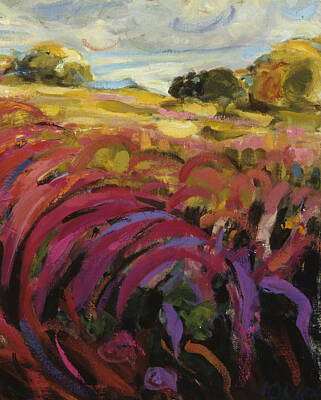The Purple Loosestrife
Pristine pretty
Virgin apotheosis
Precise in it’s symbiosis
To flourish as one.
Any weed an unfortunate flower
Only to the outsider
And those who judge.
There,
Time is just revolving
All,
Already has been resolved.
Resplendent by
Shared dependency
Evolved.
Until
Fragility is poked
By the conquerors with curious and dirty hands
Swollen
Emboldened
And billowing
With unblinking demands
Innocence unsuspecting
A disturbance at life
Man, the coveted stranger
And the menace of
Purple loosestrife.

Purple Loosestrife -- Jane Oriel

Purple Loosestrife -- Jane Oriel
The purple loosestrife (Lythrum salicaria) has a square stem, narrow stalkless leaves, and spikes of purple, pink, or white star-shaped flowers. It is mainly associated with boggy areas, river banks, and ponds and forms clonal colonies 1.5 meters in width with numerous 1-2 m stems growing from a single woody root mass. The flowers are 10–20 mm in diameter, with six (sometimes five) petals and 12 stamens (each with up to 3,000 tiny seeds which are easily spread by water, wind, wildlife and humans; each plant can grow as many as 30 flowering stems that can produce up to 2.7 million seeds each year). Native to Europe and Asia, it was taken to North America in the early 19th century in dirt that was used as ballast and then spread by bee keepers, due to its abundance of flowers which provide a large source of nectar. It became highly invasive, reducing the nutrients and space needed by native plants (especially cattails), degrading habitats for birds, insects, amphibians, algae, and other wildlife, clogging irrigation canals, degrading farm land, and reducing the forage value of pastures. In 1992, the Canadian and American governments approved the release of two European leaf-eating beetles that feed primarily on the plant and can reduce populations by up to 90%. Some of the species of Lythrum are heterostylous, meaning that two or three morphological types "morphs") exist; all flowers on the same plant share the same morph and are heteromorphically self-incompatibile (the pollen from a flower on one morph cannot fertilize another flower of the same morph). The lengths of the stamens and pistils are adapted for pollination by different pollinators, so pollen originating in a long stamen will primarily reach long pistils, and pollen from a short stamen will reach reach short pistils. Some loosestrifes are distylous: In one morph (the "pin" or "longistylous" flower) the stamens are short and the pistils are long, and in the other ("thrum" or "brevistylous" flower) the opposite is true, and the pistils are the same length as the stamens of the other morph. However, the purple loosestrife is tristylous: Each morph has two types of stamens, a short pistil and stamens which are long and intermediate; an intermediate pistil is intermediate and stamens which are short and long; or a long pistil and stamens which are short and intermediate. [Several species within a different genus (Lysimachia) are also commonly called loosestrife, but they usually have yellow flowers; they are named after a Sicilian king who fed them to a mad ox to calm it. Bees of the genus Macropis pollinate oil-producing Lysimachia plants and exclusively use Lysimachia floral oils to provision their cells and build theirs nests.]
ReplyDeleteAll that pollination talk with it's pistils and stamens and thrum and distylous, tristylous got me all aflutter. Whoops! Thank you for clearly shedding light on my clumsy attempt to loose strife. :))
ReplyDelete